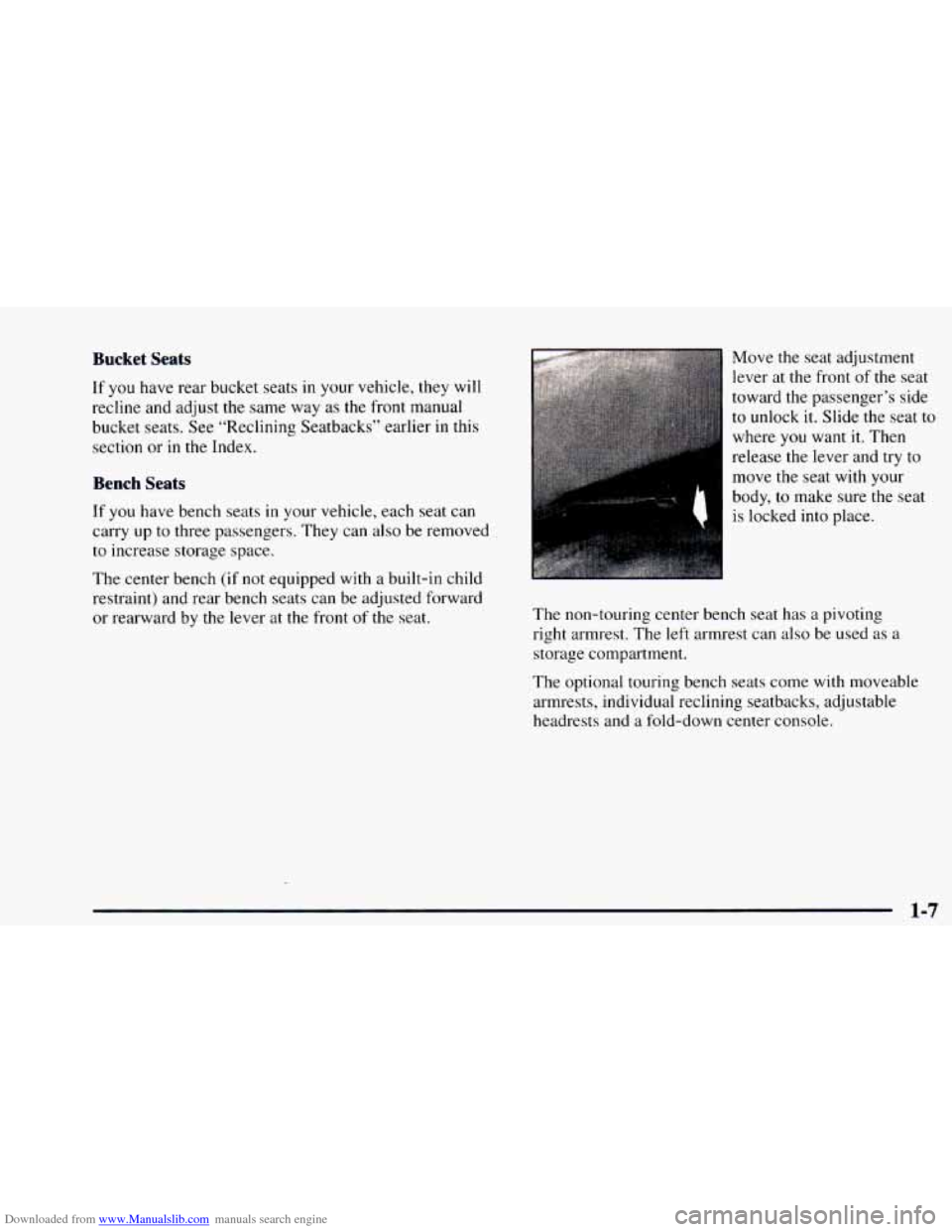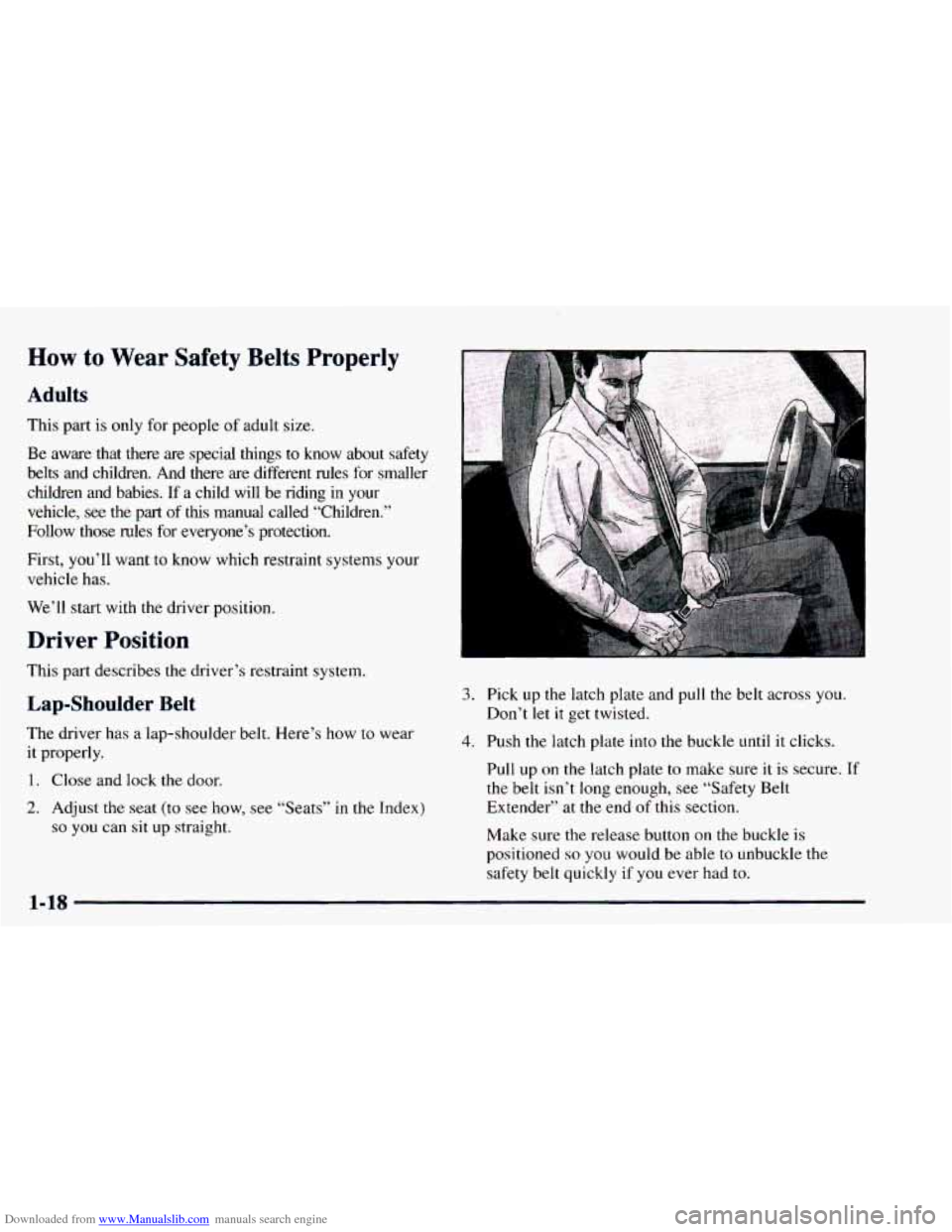Page 7 of 404
Downloaded from www.Manualslib.com manuals search engine Vehicle Symbols
These are some of the symbols you may find on your vehicle.
For example,
these symbols
are used on an
original battery:
POSSIBLE A
CAUTION
INJURY
PROTECT EVES BY
SHIELDING
CAUSTIC
ACID COULD BATTERY
CAUSE
BURNS
AVOID
SPARKS
OR
FLAMES
SPARK
OR ,111,
COULD FLAME
EXPLODE BATTERY
These symbols are important
for you and
your passengers whenever your
vehicle
is
driven:
UNLOCK Esl
FASTEN
SEAT
BELTS
POWER
WINDOW
These symbols have
to do with
your lamps:
SIGNALS 6 e
TURN
FOG LAMPS
$0
These symbols
are
on some of
your controls:
WINDSHIELD
WIPER
WINDSHIELD DEFROSTER
WINDOW
DEFOGGER
These symbols are used
on
warning and
indicator lights:
COOLANT -
TEMP -
CHARGING BATTERY
SYSTEM
BRAKE
(0)
R.
ENGINE OIL w,
PRESSURE
ANTI-LOCK
(@)
BRAKES
Here are some
other symbols you may see:
FUSE
I
LIGHTER m
HORN )a(
SPEAKER
b
FUEL e3
V
Page 10 of 404
Downloaded from www.Manualslib.com manuals search engine Seats and Seat Controls
This section tells you about the seats -- how to adjust
them, take them
out and put them back in. It also tells
you about bucket and bench seats, power seats and
head restraints.
Mant-1 Front Seats
You can lose control of the v icle if you try to
adjust a manual driver’s seat while the vehicle is
2-Way Front Seat
The bucket seats can be
adjusted forward or
rearward by the lever at
the
front of the seat.
moving. The sudden movement could startle and
confuse you, or make you push a pedal when you
don’t want to. Adjust the driver’s seat only when the vehicle is not moving. Move the seat adjustment lever at the front of the seat
toward
the driver’s door to unlock it. Slide the seat to
where you want it. Then release the lever and try to
move the seat with your body, to make sure the seat is
locked into place.
1-2
Page 12 of 404
Downloaded from www.Manualslib.com manuals search engine Reclining Seatbacks
There is a lever on the inside of the seat to adjust the seatback.
You can adjust the seatback
by lifting the lever. Release
the lever
to lock the seatback
where you want
it. Pull up
on the lever and the seat will
go to an upright position.
But don’t have
a seatback reclined if your vehicle is moving.
~
Sitting in a reclined position when your vehicle is
in motion can be dangerous. Even if you buckle
CAUTION: (Continued)
1-4
Page 14 of 404

Downloaded from www.Manualslib.com manuals search engine After the latch has been released, push the seatback
toward the front
of the vehicle until it locks in place. To
raise the seatback, unlock the seatback latch by pushing
up on the lever while pushing down on the upper edge
of the seatback. Move the seatback into the upright
position. Make sure
the seatback is locked when it is
bacl 1 th lpright position.
A CAUTION:
If the seatback isn’t locked, it could move
forward in
a sudden stop or crash. That could
cause injury to the person sitting there. Always
press rearward
on the seatback to be sure it
is locked.
Rear Seats
A CAUTION:
A seat that isn’t locked into place properly can
move around
in a collision or sudden stop. People
in the vehicle could be injured. Be sure to lock
the seat into place properly when installing it.
A CAUTION:
- I
A safety belt that is twisted or not properly
attached won’t provide the protection needed in
a
crash. The person wearing the belt could be
seriously injured. After installing the seat, always
check to be sure that the safety belts are not
twisted and are properly attached.
1-6
Page 15 of 404

Downloaded from www.Manualslib.com manuals search engine Bucket Seats
If you have rear bucket seats in your vehicle, they will
recline and adjust the same way as the front manual
bucket seats. See “Reclining Seatbacks” earlier
in this
section or
in the Index.
Bench Seats
If you have bench seats in your vehicle, each seat can
carry up to three passengers. They can also be removed
to increase storage space.
The center bench (if not equipped with
a built-in child
restraint) and rear bench seats can be adjusted forward
or rearward by
the lever at the front of the seat. Move
the seat adjustment
lever at the front of the seat
toward the passenger’s side
to unlock it. Slide the seat to
where
you want it. Then
release the lever and try to
move the seat with your
body,
to make sure the seat
is locked into place.
The non-touring center bench seat has
a pivoting
right armrest. The left armrest can also be used as
a
storage compartment.
The optional touring bench seats come with moveable
armrests, individual reclining seatbacks, adjustable
headrests
and a fold-down center console.
1-7
Page 17 of 404
Downloaded from www.Manualslib.com manuals search engine Removing the Rear Seats
To remove the rear seats, do the following:
c I TO DETACH
‘1 BELT FOR
SEAT REMOVAL
-9.- I
INSERT KEY , 1
INTO HOLE
AND PUSH I
I I
1 I
1. If you are removing the
center seat, remove the
right lap-shoulder belt.
To do this, press the tip
of a key into the release
hole of the safety belt
attachment while pulling
up on the safety belt.
2. If you have a safety belt
guide on
your seat, pull
the
safety belt all the way
I, out through the guide.
3. Pull up on the seatback latch on the right rear of the
front seat. Push the seatback
down until it locks in
place (non-touring bench seats only).
1-9
Page 19 of 404
Downloaded from www.Manualslib.com manuals search engine Replacing the Rear Seats
To replace the rear seats, do the following:
1. Lower the seat into position. Make sure the front
retainers are hooked onto the anchor pins.
2. Pull the seat down to latch the rear retainers. Make
sure the seat
is locked in by pulling up and down on
the seat.
3. Raise the seatback by pushing forward on the latch at
the right rear of the seat, while pushing down on the
upper edge of the seatback. Pull up on the seatback
until
it is locked securely in the up position.
1-11
Page 26 of 404

Downloaded from www.Manualslib.com manuals search engine How to Wear Safety Belts Properly
Adults
This part is only for people of adult size.
Be aware that there are special things to know about safety
belts and children. And there are different rules for smaller
children and babies. If a child will be riding in your
vehicle, see the
part of this manual called “Children.”
Follow those rules for everyone’s protection.
First, you’ll want to know which restraint systems your
vehicle has.
We’ll start with
the driver position.
Driver Position
This part describes the driver’s restraint system.
Lap-Shoulder Belt
The driver has a lap-shoulder belt. Here’s how to wear
it properly.
1. Close and lock the door.
2. Adjust the seat (to see how, see “Seats” in the Index)
so you can sit up straight.
“i
3. Pick up the latch plate and pull the belt across you.
Don’t let
it get twisted.
4. Push the latch plate into the buckle until it clicks.
Pull up
on the latch plate to make sure it is secure. If
the belt isn’t long enough, see “Safety Belt
Extender” at
the end of this section.
Make sure
the release button on the buckle is
positioned
so you would be able to unbuckle the
safety belt quickly
if you ever had to.
1-18